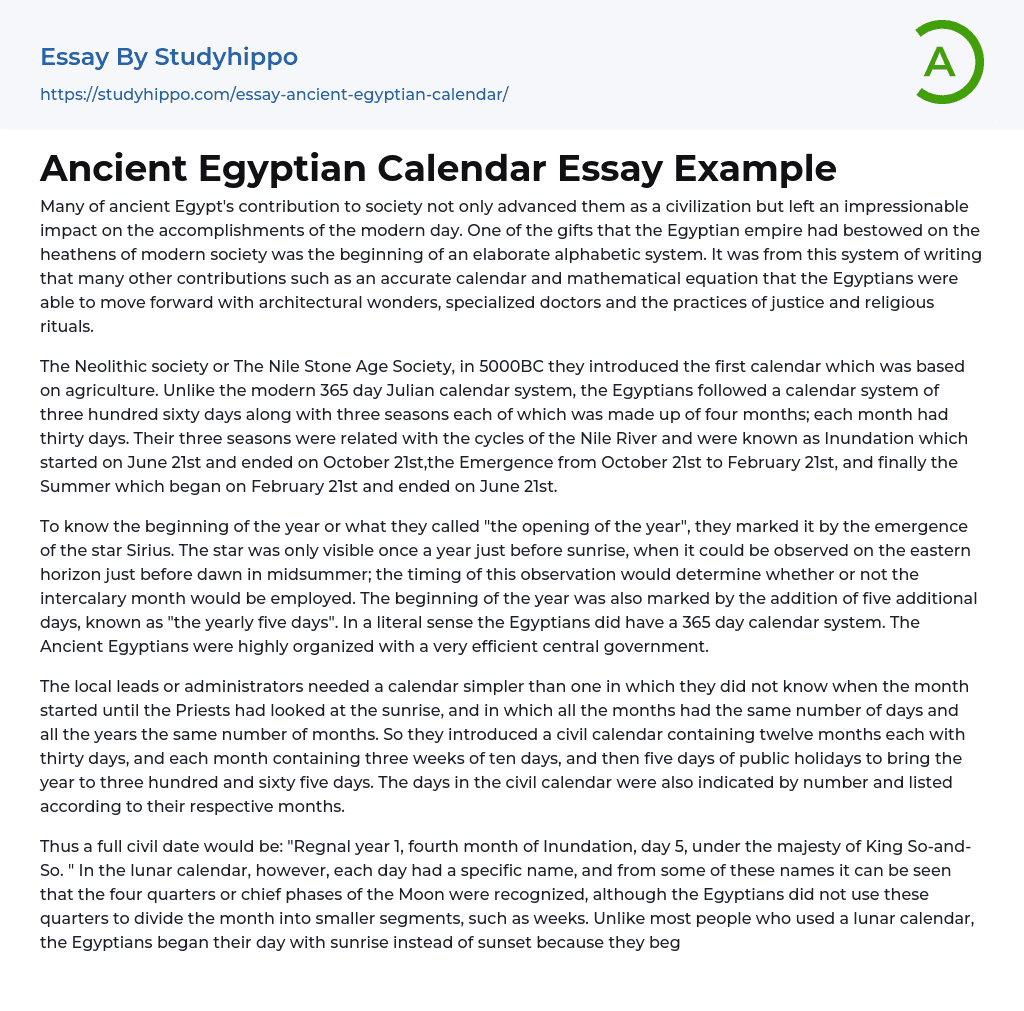Many of ancient Egypt's contribution to society not only advanced them as a civilization but left an impressionable impact on the accomplishments of the modern day. One of the gifts that the Egyptian empire had bestowed on the heathens of modern society was the beginning of an elaborate alphabetic system. It was from this system of writing that many other contributions such as an accurate calendar and mathematical equation that the Egyptians were able to move forward with architectural wonders, specialized doctors and the practices of justice and religious rituals.
The Neolithic society or The Nile Stone Age Society, in 5000BC they introduced the first calendar which was based on agriculture. Unlike the modern 365 day Julian calendar system, the Egyptians followed a calendar system of three hundred sixty day
...s along with three seasons each of which was made up of four months; each month had thirty days. Their three seasons were related with the cycles of the Nile River and were known as Inundation which started on June 21st and ended on October 21st,the Emergence from October 21st to February 21st, and finally the Summer which began on February 21st and ended on June 21st.
To know the beginning of the year or what they called "the opening of the year", they marked it by the emergence of the star Sirius. The star was only visible once a year just before sunrise, when it could be observed on the eastern horizon just before dawn in midsummer; the timing of this observation would determine whether or not the intercalary month would be employed. The beginning of the year was also marked by the addition of five additiona
days, known as "the yearly five days". In a literal sense the Egyptians did have a 365 day calendar system. The Ancient Egyptians were highly organized with a very efficient central government.
The local leads or administrators needed a calendar simpler than one in which they did not know when the month started until the Priests had looked at the sunrise, and in which all the months had the same number of days and all the years the same number of months. So they introduced a civil calendar containing twelve months each with thirty days, and each month containing three weeks of ten days, and then five days of public holidays to bring the year to three hundred and sixty five days. The days in the civil calendar were also indicated by number and listed according to their respective months.
Thus a full civil date would be: "Regnal year 1, fourth month of Inundation, day 5, under the majesty of King So-and-So. " In the lunar calendar, however, each day had a specific name, and from some of these names it can be seen that the four quarters or chief phases of the Moon were recognized, although the Egyptians did not use these quarters to divide the month into smaller segments, such as weeks. Unlike most people who used a lunar calendar, the Egyptians began their day with sunrise instead of sunset because they began their month, and consequently their day, by the disappearance of the old Moon just before dawn.
As was customary in early civilizations, the hours were unequal, daylight being divided into 12 parts, and the night likewise; the duration of these parts varied with
the seasons. Both water clocks and sundials were constructed with notations to indicate the hours for the different months and seasons of the year. The standard hour of constant length was never employed in ancient Egypt. To conclude the Egyptians contribution brought many benefits not only to their society but also to the whole world.
Bibliography
http://www.kingtutshop.com/freeinfo/Ancient-Egyptian-Calendar.htm
https://www.britannica.com/science/Egyptian-calendar
- Abolitionism essays
- Adam Smith essays
- American History essays
- American Revolution essays
- Ancient Egypt essays
- Articles Of Confederation essays
- Atlantic Slave Trade essays
- Aztec essays
- Benjamin Franklin essays
- Civil Rights Act of 1964 essays
- Civil Rights Movement essays
- Civil war essays
- Cleopatra essays
- French And Indian War essays
- Gettysburg essays
- Great Depression essays
- Hurricane Katrina essays
- Industrial Revolution essays
- Jamestown essays
- Manifest Destiny essays
- Mccarthyism essays
- Patrick Henry essays
- Pearl Harbor essays
- Pocahontas essays
- Prohibition essays
- Pyramids essays
- Salem Witch Trials essays
- Slavery essays
- The New Deal essays
- Thirteen Colonies essays
- Westward Expansion essays
- Egypt essays
- Iran essays
- Iraq essays
- Israel essays
- Saudi Arabia essays
- Syria essays




